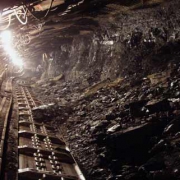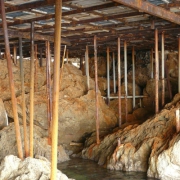FLNG – great technology, wrong business model
This blog is almost two years old now and I have been asked multiple times why I avoided the F-word. Let’s clear up that misconception right now – I am not avoiding it. There only was so much else happening in energy that gave me more thrills than Floating LNG.
And here we go right to the heart of the matter. I simply did never attach enough importance to Floating LNG to give it prominent coverage.
Many of those living to the tune of LNG strongly disagreed – so far. GDF and Santos have recently announced that they would scrap their ill-fated Bonaparte LNG venture.
FLNG is still bobbing on an enormous hype as it’s easy to see by judging the sheer number of events and roundtables on and off the topic. However, is the attention deserved?
Let us get one more thing straight right away. I do not think that any FLNG project would be stupid by nature. I stand in awe when looking at many of the technologies employed in it and some FLNG concepts make a horrible lot of sense to me. Failure is not necessarily in the fabric of it.
But first things first. What is wrong with FLNG then?
At the beginning of my LNG years, I had been confronted with a statement made by an old process engineer who happened to have tons of marine experience. “Whatever you do on firm land invariably becomes more expensive on the deck of a seagoing vessel for two reasons:
- first, space is scarce so processes cannot be properly spaced which adds to cost and complexity and
- second not every process that performs well on solid ground still does so on ground that moves often – i.e. the deck of a vessel”.
What stuck with me was that, whenever I would have a reasonable choice to go onshore, I would do so as anything offshore would increase cost and likelihood of failure because of increased complexity.
That is already a tough nut to swallow if done in a more settled industry. For LNG however, it becomes suicidal as the industry goes through the stormiest upheavals in its multi-decade existence.
One must make a clear distinction between floating liquefaction and floating regasification. They are being lumped together under the same heading for the sake of convenience but both could not be more different.
Whereas regasification is a technologically very simple process and because consuming markets tend not to be in the middle of nowhere – where even simple things such as rotating staff is a challenge and very costly – liquefaction is a series of gas cleaning and conditioning steps plus refrigeration (i.e. liquefaction or heat exchange through intermediate substances that are often flammable and hence dangerous) plus the problem that one has to dispose of the unwanted stuff such as sulfur to name but one.
This is not really something you want to do on a cramped, rock-n-rolling deck of a vessel (even one as big as Prelude). Floating regasification simply requires one to deal with sloshing – this would only make your vessel heavier but would not add complex or dangerous processes to technical complexity.
However, let’s push the cork a little further. The whole FLNG madness is nothing but another instance of the general insanity that seems to have encompassed LNG as a whole, especially so in the Pacific basin. It is a bit like money has no value and everything – that can be done – must be done. Just because something can be done is seldom a good economic foundation for a particular course of action.
I have said it countless times – there are reserves of Natural Gas that should never be punctured for the gas is so expensive to lift in the first place, it becomes unsellable. The same thing is true for process technology and or logistics.
Speculating on eternal stratospheric prices in any given market and those prices to be sustainable for decades is not only foolish. It is outright criminal.
Big-ticket LNG projects are hyper-expensive without the junk and they require decades of stable revenues to earn their investment back. No market on earth offers safe, sky-high returns for decades. The pain resulting from high-energy prices in any given market usually incites reactions (at least in the long run) and they usually come in the disguise of competitors developing any alternatives they can dream up. Who believes that a decade of entrepreneurs developing solutions for ending any given stranglehold would not eventually produce results?
Project Developers going for fancies such as FLNG are often wilfully turning a blind eye to reality.
Before this becomes even more of a rant, let’s turn our eye back on FLNG. Is it all doomed then?
No way. FLNG, if done sensibly, can be a solution to many difficult situations. And here I talk about floating liquefaction. I am not trying to square the circle. All I intend to do is bring back some common sense to this wretched issue as not every situation can be compared to the other.
Sometimes the worst problems of FLNG can be dealt with in a close-to-the-shore environment. A typical situation would be a river mouth such as the Niger Delta that is awash with Natural Gas flaring but also is crisscrossed by waterways and dotted with countless swamps. It’s still very calm waters so sloshing would not be an issue just as spacing is usually not a problem. Many things can still be done onshore – only the critical pieces of the liquefaction process might sit on a barge instead of on solid ground. The advantages are clear. Building the most expensive piece of the liquefaction chain in a workshop environment instead of in the jungle would sometimes weigh up the cost of the barge.
Or sometimes you have to be quick and use an LNG transport vessel as floating storage on a fixed jetty until your heavier gear comes online.
Such installation would very likely not be as large as Prelude or the would-be Bonaparte LNG but they would not be destined to the global market in the first place. They would serve more regional markets with different needs. Any many of them would be exotic situations not allowing one to generalize.
Large-scale FLNG would probably never really be economical as the extremely high cost of doing so would probably justify investments in any alternatives. And with alternatives, I mean alternative ways of getting what we covet most. Clean heating, cooling, light, and movement, and what could be better placed than methane to make it all happen? This methane does not necessarily have to be pulled from the ocean floor. Manufacturing it is another way and it will eventually be more interesting than floating marvels of technology in the middle of Waterworld.
Who wants to convince me now that there can be no other miracle development after shale becomes a monster in the US?


















Leave a Reply
Want to join the discussion?Feel free to contribute!